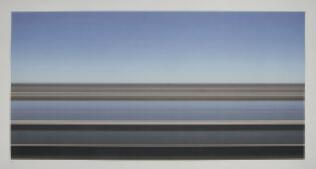Mariano Favetto
Galerie Argentine Paris
The landscape is, in fact, the summary or the visual product of a contemplative attitude with respect to the world that initially manifested itself exclusively in the reproduction of fields, skies and seas, but later projected itself strongly to encompass the rest of the world. In this wide and nonstrict sense, photography as a whole is inseparable from landscape depiction. Moreover, it is the first of a series of technical revolutions in the field of image production, whose most recent achievement is the digitally generated image, and which have contributed to expand and perfect the landscape rendition which became explicit for the first time in landscape painting.

For − as it has already been highlighted by thinkers as diverse as Walter Benjamin or Gilles Deleuze − what photography did at a certain point was what the Dutch landscape paintings had already done in their day and through specific mediums: to ascribe importance to that which has none.
As part of this new generation of Latin American artists, Mariano Favetto surprises with “La pampa tiene el ombú”, an ensemble of paintings and video exhibited at the Argentine Gallery in the Argentine Embassy.
Using photographs taken between the cities of Buenos Aires and Coronel Suárez, the work alters the eye’s intention, the habitual gaze, forcing the viewer to explore almost microscopic ver- sions of a cosmos composed of pixels and deconstructed forms. The virtual landscapes, an intriguing combination of paradoxical images and concepts, put ideas to work and generate unlimited lyrical variations. They require a penetrating gaze to try to decipher the real and the fictional clues that the artists intertwines. In a dual-purpose action, the work legitimizes everyday life and throws light on a rupture that endows it with a revealing dimension, rich and unexpectedly out of time and space.
A multimedia artist and an imaginative creator, Favetto approaches each work as if it were a study of harmonious arrangements and visual resources that serve to transcend exact moments in time, inviting the viewers to discover, participate, and interpret. Through the process of creation of these images, the artist challenges our way of seeing, and what was familiar becomes a subject of contemplation, governed by a totally different set of rules and associations based on the concept of fractals, the mathematical equation that generates a form in which each part is equal to the whole, and which was the basis for digital representation.
The different time frames that imply movement in space reflect a series of diverse perceptions that the artist discovered when he returned to Buenos Aires after an absence of more than ten years, and which expanded his awareness regarding the exact meaning of those perceptions. Sight is a form of intelligence, and identification is a form of well-being. Favetto’s work questions the pro- cesses of visual perception, stimulates doubt and our capacity to look at things and analyze them. His images comfort us with regard to our feeling of familiarity, but above all, they render us capable of inverting the identification process. Mariano Favetto evokes nature as a mystery, conveying the peacefulness he feels through its visual contact. Each photograph is tempered by the personal message of the artist, who has focused on creating a har- mony that contains all his realities of different places. For each photograph, he has designed a personal invitation to see the world. Through this refinement restrained to the smallest part, the pixel, the image becomes a furtive evocation, a synthetic vision in which sky, land and cloud intertwine.





